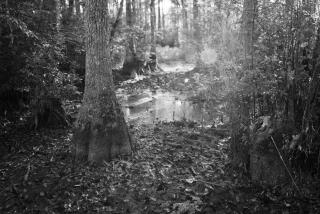Voices From a Pivotal Era in American History Still Echo Today
- Share via
On Feb. 12, 1831 (Abraham Lincoln’s 22nd birthday, as it happened), Americans from Maine to Louisiana were looking skyward through bits of smoked glass to see the much-heralded solar eclipse. While superstitious folk of previous ages may have feared that such events portended war, disaster or even the end of the world, enlightened 19th century commentators took a far more reassuring view: “Idle fears and gloomy forebodings. . .” one writer claimed, “have yielded to pleasing admiration. . .” Another hastened to point out that eclipses “result from the established laws of the planetary revolution, and take place in exact conformity of those laws.” But many Americans, as historian Louis P. Masur reminds us, were still fearful.
Like many ballyhooed events, the Great Eclipse of 1831 did not live up to its billing. Viewers who had been led to expect a complete darkening of the heavens, with the moon and stars shining as brilliantly as at night, were disappointed: “The darkness was that of a thunder gust,” snorted one observer. But, if the heavens that year were insufficiently dramatic, there was plenty of drama on earth, from Jan. 1, when William Lloyd Garrison published the first issue of his Abolitionist newspaper, the Liberator, all the way through to December, when a worldwide epidemic of cholera reached American shores.
The year of 1831 also saw scandal in the Jackson White House, the forced removal of the Cherokees from their land, Nat Turner’s rebellion, conflicts over slavery and tariffs, John Calhoun’s espousal of nullification, the spread of evangelical revival and the dawn of the railroad age. (An early passenger likened the experience to “sailing on dry land.”) John James Audubon was busy painting--and killing--the “Birds of America,” Alexis de Tocqueville and Gustave Beaumont were examining American society and, in Boston, a choir introduced a new patriotic hymn that began “My country, ‘tis of thee.”
Masur, a professor at the City College of New York, has chosen 1831 as a kind of microcosm, allowing us to examine some of the people, ideas and events that were feeding into the turbulent flow of American history. Rather than proceed chronologically, month by month, Masur divides “1831” into four thematic sections: “Slavery and Abolition,” “Religion and Politics,” “State and Nation” and “Machines and Nature.” Drawing on speeches, pamphlets, diaries, letters and newspaper and magazine articles, he creates a lively and colorful portrait of the era, not only presenting classic issues such as slavery, tariffs and states’ rights in a fresh way, but also focusing on now-forgotten issues that loomed large at the time. One of the biggest political stories of 1831 was the anti-Masonic movement, which was spurred by cases of Masons shielding fellow Masons from justice. The short-lived Anti-Masonic Party was the first in America to hold a presidential nominating convention. Its candidate, William Wirt, was also the counsel who pleaded the case of the Cherokees before the Supreme Court.
It is interesting to be reminded that, well before Karl Marx had published his “Communist Manifesto,” American reformer Thomas Skidmore was calling for a redistribution of the nation’s wealth. And long before Margaret Sanger, Robert Dale Owen was advocating birth control (withdrawal or the insertion of a sponge were among the methods he suggested). In 1831, these two reformers quarreled, Owen believing birth control (along with free education) would help poor working families, Skidmore insisting that the cause of poverty was not large families but an exploitative system that favored the rich.
Many of the voices of “1831” have a haunting resonance, such as that of the Abolitionist minister who noted that, because “men are apt to dislike most those whom they have injured most,” racial prejudice was deepened “by the secret consciousness of the wrong we are doing them.” And some of the arguments about the Constitution still sound familiar. As the gap between proponents of states’ rights and defenders of the Union grew wider, the aging James Madison, asked to clarify the intentions of his fellow Founding Fathers, came down unequivocally on the side of Union, denying the claims of states’ rights advocates that they were acting in the tradition of Jefferson: That Jefferson “ever asserted a right in a single State to arrest the execution of an act of Congress is countenanced by nothing ever said or done by him,” Madison declared. This, as any student of American history well knows, did not deter Calhoun and his ilk.
“1831” is the kind of solidly researched, briskly presented popular history that helps sharpen our picture of a surprisingly pivotal era.
More to Read
Sign up for Essential California
The most important California stories and recommendations in your inbox every morning.
You may occasionally receive promotional content from the Los Angeles Times.













